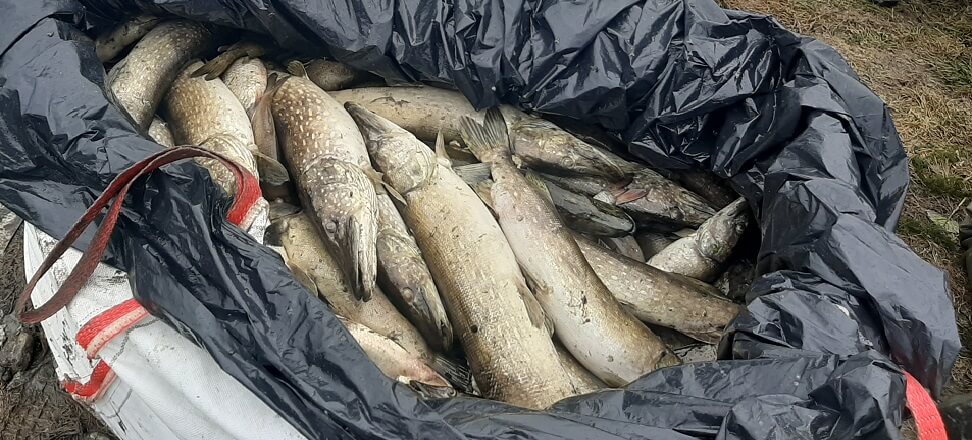August on the Oder, or the beginnings of emergency event investigations
Due to the ecological situation in the Oder River in August 2022, which led to massive die-offs of fish, mollusks and crustaceans, one of the priority actions became an urgent investigation of the state of the river’s ichthyofauna. After receiving information about the pollution of the Oder River, a team from the Department of River Fisheries, Stanislaw Sakowicz Inland Fisheries Institute – State Research Institute (IRS-PIB), left immediately for the site. Employees interrupted their vacations, all the institute’s resources and capacities were directed to field and laboratory investigations to identify the causes of the situation in the river. Everyone gave their 100% performance – from the rank-and-file employee to the management.
Our teams spent almost three months on the Oder River. What we found at the site was horrifying – thousands of dead fish and an immeasurable number of dead mollusks flowing downstream. The smell by the river was disgusting. Equally shocking was the sight of residents, servants and anglers measuring themselves against an unknown adversary and a fear compounded by media reports. We prioritized field reconnaissance, which included taking the first water samples (which later proved to be crucial for the detection of “golden algae”), making photographic documentation using a drone, and performing ichthyopathological tests. With specialized equipment on board the aircraft, we created maps of the river, giving a detailed picture of the situation. In addition, we tried to help coordinate the work of services and anglers as much as possible.
Another task was to determine the species composition of the dead fish and measure their weight and length. At the peak of the August die-offs, we measured more than 4,500 individuals belonging to 23 species. Fish, but also snails and mussels, flowing down the current of the Oder River, were fished out with landing nets by anglers, fishing guards, firefighters and soldiers. The trapped material was dominated by individuals with larger body sizes, which was partly due to the method of collection. Among the fish we measured, four species dominated: bream, perch, ruffe and roach, whose combined share was 76% of the total number of individuals caught. Another four species: bream, pike, catfish and tench accounted for a total of 16% of the fish measured.
In addition to the Department of River Fisheries of the IRS-PIB, employees of other units of the Institute also took part in the research, both in the field and in laboratories. The joint efforts resulted in the detection in mid-August by Dr. Agnieszka Napiórkowska-Krzebietke, prof. IRS-PIB, the abundant haptophyte Prymnesium parvum, or so-called. “golden algae” that produces powerful toxins.
In-depth analysis of the problem, that is, research within the framework of the State Environmental Monitoring
Massive fish die-offs in the Oder River ceased in late August and early September, but still unanswered were the questions posed at the time: how many fish fell victim to P. parvum toxins and what is the current state of the Oder ichthyofauna population. In an effort to answer them, we took advantage of the opportunities provided by the State Environmental Monitoring (PME). As part of the regular ichthyofauna surveys for the classification of the ecological status/potential of rivers, carried out at PMŚ on behalf of the Chief Inspectorate of Environmental Protection under the direction of our Department, it was decided to increase in 2022. The number of fishing posts on the Oder River. Their location covered the entire length of the river within Polish borders. The surveys were conducted in September and October, using a trapping technique that is standard in river monitoring, based on a single electrofishing. The advantage of the method used is that it minimizes the mortality of the fish and lampreys studied. The detailed results of this work are included in the report on the implementation of the 2022 monitoring of river ichthyofauna, published on the GIOŚ website.
As a result of the surveys, about 5,500 were caught at the analyzed sites. Fish belonging to 30 species, with a total weight of approx. 100 kg. The most numerous representatives (>1,000 individuals) were roach and perch, and the highest weight share (>10 kg) was characterized by chub, pike, perch and roach.
The results of the fall 2022 survey were compared. with the Oder River monitoring results from earlier years and with archival data. The average number of fish and the weight of the catch were shown to have decreased by about. 50%. In the best-studied section of the free-flowing Oder River, the loss of fish population per hectare of water is close to 80%. Such a condition is largely due to the shape of the channel, hydraulic conditions and, consequently, the spatial distribution of habitats. A high mortality rate of mollusks was also recorded in the free-flowing section of the Oder River. Mostly empty shells were found attached to the ground or buried in the bottom. Losses in the population of bivalves (scrapers and bark beetles) will negatively affect the size of the population of the roseate (an ostracophilic species that uses bivalves for reproduction).
Particularly noteworthy in the catches are protected species that are not subject to fishing and angling management (with the exception of barbel and asp – species from the annexes of the Natura 2000 Habitat Directive). In monitoring catches conducted in the Oder River in 2022, eight species under various forms of protection were found. These were: asp, barbel, white gudgeon, common goat, hellbender, piscator, roseate and slipper. Based on the PMŚ data, it can be noted that in the free-flowing section of the Oder River there is a great deal of habitat important for the bitterling and the common goat, which species there show some of the highest river densities nationwide.
What does this mean for the fishery of the Oder River?
Based on literature data, it can be assumed that the core assemblage of the Oder River ichthyofauna consists of about 30 species. Observed in such a short period of time, the deaths of so many species of fish, testify to the enormous scale of the event, taking place in August 2022. and covering the entire assemblage of ichthyofauna inhabiting the Oder River.
The consequences of such massive die-offs will likely require years of restoration and the involvement of relevant public services. Therefore, it is necessary to launch a program to monitor the status of fish populations, taking into account the effects of natural reproduction and age structure.
It is necessary to create a network of continuous monitoring points for surface water quality and a “rapid response” group of experts responsible for assessing the threat, which will minimize the impact of negative effects on the water environment.
Supporting the recovery of the ichthyofauna assemblage could be the implementation of the Oder River restoration program, whose activities would be directed at increasing the diversity and availability of refugia (restoration of oxbow lakes, restoration of spawning and breeding habitats). This process requires the creation of a platform for interdisciplinary dialogue between experts in civil engineering and ecology in the broadest sense.
The authors are staff members of the St. Petersburg Inland Fisheries Institute. Stanislaw Sakowicz – National Research Institute, Department of River Fisheries in Zabieniec. The Department of River Fisheries conducts studies of ichthyofauna in river ecosystems. Their scope includes: monitoring of ichthyofauna for the possibility of use, protection and restoration; optimization of the use of natural production of rivers and dam reservoirs (fishing exploitation, stocking); methods of protection and renaturalization of rivers; research related to the impact of regulation and development of rivers on ichthyofauna, as well as the possibility of minimizing their negative effects. Monitoring the effectiveness of fish ladders, protecting fish at water intakes used for industrial purposes. Implementation of research results into fishing practice and their application in legally protected areas (National and Landscape Parks, Natura 2000 areas).

 Polski
Polski






